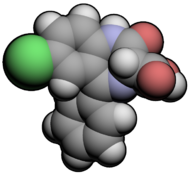
Back كلورازيبات Arabic Clorazepat Catalan Clorasepad Welsh Clorazepat German Clorazepato Spanish کلرازپات Persian Kloratsepaatti Finnish Clorazépate French Clorazepate Galician קלוראזפאט HE
 | |
 | |
| Clinical data | |
|---|---|
| Trade names | Tranxene, Tranxilium, Novo-Clopate |
| Other names | Clorazepate dipotassium |
| AHFS/Drugs.com | Monograph |
| MedlinePlus | a682052 |
| Routes of administration | Oral |
| ATC code | |
| Legal status | |
| Legal status |
|
| Pharmacokinetic data | |
| Bioavailability | 91% |
| Metabolism | Hepatic |
| Elimination half-life | 48 hours |
| Excretion | Renal |
| Identifiers | |
| |
| CAS Number |
|
| PubChem CID | |
| IUPHAR/BPS | |
| DrugBank | |
| ChemSpider | |
| UNII | |
| KEGG | |
| ChEMBL | |
| CompTox Dashboard (EPA) | |
| ECHA InfoCard | 100.041.737 |
| Chemical and physical data | |
| Formula | C16H11ClN2O3 |
| Molar mass | 314.73 g·mol−1 |
| 3D model (JSmol) | |
| |
| |
| | |
Clorazepate, sold under the brand name Tranxene among others, is a benzodiazepine medication. It possesses anxiolytic, anticonvulsant, sedative, hypnotic, and skeletal muscle relaxant properties. Clorazepate is an unusually long-lasting benzodiazepine and serves as a prodrug for the equally long-lasting desmethyldiazepam, which is rapidly produced as an active metabolite. Desmethyldiazepam is responsible for most of the therapeutic effects of clorazepate.[2]
It was patented in 1965 and approved for medical use in 1967.[3]
- ^ Anvisa (2023-03-31). "RDC Nº 784 - Listas de Substâncias Entorpecentes, Psicotrópicas, Precursoras e Outras sob Controle Especial" [Collegiate Board Resolution No. 784 - Lists of Narcotic, Psychotropic, Precursor, and Other Substances under Special Control] (in Brazilian Portuguese). Diário Oficial da União (published 2023-04-04). Archived from the original on 2023-08-03. Retrieved 2023-08-16.
- ^ Ochs HR, Greenblatt DJ, Verburg-Ochs B, Locniskar A (October 1984). "Comparative single-dose kinetics of oxazolam, prazepam, and clorazepate: three precursors of desmethyldiazepam". Journal of Clinical Pharmacology. 24 (10): 446–451. doi:10.1002/j.1552-4604.1984.tb01817.x. PMID 6150943. S2CID 24414335. Archived from the original on 2009-07-20. Retrieved 2009-05-31.
- ^ Fischer J, Ganellin CR (2006). Analogue-based Drug Discovery. John Wiley & Sons. p. 536. ISBN 9783527607495.